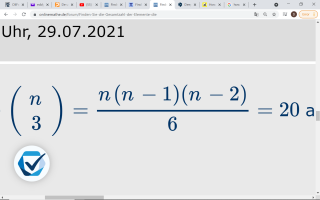eddy2017
Elite Member
- Joined
- Oct 27, 2017
- Messages
- 2,525
hi to all teachers;
I'm having trouble understanding the end of this problem.
if you don't want to help is okay, i am just posting it. if you do help, please follow the 'I'M STUCK' ,WHAT NOW? , MAKE IT AS EASY AS POSSIBLE. MATH IS NOT SO COMPLICATED IF EXPLAINED CLEARLY mantra.
This is it:
From a total of elements, groups of 3 are made.
Regardless of the order in which the groups are combined.
The total number of groups that can be formed is equal to 20.
Find the total number of elements that satisfy this condition:
(n/3)=20
I have seen this exercise done on a video and I understood up to a certain point.
The formula for combinations is
(n/k)=n!/((n-k)!k!)= 20
We have that k =3 ( groups of 3)
I substitute k for its value,
Then,
n/3= n!/(n-3)!3! =20
the teacher, in the video, decides to clear n!
multiplying (n-3)! 3! on both sides of the equality,
Thus, the result is,
n!=20(n-3)! 3!
then he says:
To construct a factorial number you know that you must have all the integer factors in an increasing way and none missing.
We go on to decompose the factorials ...
I understood this
20 (n-3)! =? 3! = 3*2*1
4*5
2*4
factors =1,2,3,3,4,5
then,
n!=1*2*3*4*5(n-3)
Then says the teacher,
I quote 'so far you have that n! is greater than 5! And he points out with an arrow all the factorial of 5 and if we want to continue constructing the factorial number we have to have a 6...
i lost him there. I did not understood what he did after that.
the video was in Spanish but i think i have translated everything to the letter. i did not miss anything up to the point where i stopped understanding.
thanks for any tip that leads to a solution,
eddy
I'm having trouble understanding the end of this problem.
if you don't want to help is okay, i am just posting it. if you do help, please follow the 'I'M STUCK' ,WHAT NOW? , MAKE IT AS EASY AS POSSIBLE. MATH IS NOT SO COMPLICATED IF EXPLAINED CLEARLY mantra.
This is it:
From a total of elements, groups of 3 are made.
Regardless of the order in which the groups are combined.
The total number of groups that can be formed is equal to 20.
Find the total number of elements that satisfy this condition:
(n/3)=20
I have seen this exercise done on a video and I understood up to a certain point.
The formula for combinations is
(n/k)=n!/((n-k)!k!)= 20
We have that k =3 ( groups of 3)
I substitute k for its value,
Then,
n/3= n!/(n-3)!3! =20
the teacher, in the video, decides to clear n!
multiplying (n-3)! 3! on both sides of the equality,
Thus, the result is,
n!=20(n-3)! 3!
then he says:
To construct a factorial number you know that you must have all the integer factors in an increasing way and none missing.
We go on to decompose the factorials ...
I understood this
20 (n-3)! =? 3! = 3*2*1
4*5
2*4
factors =1,2,3,3,4,5
then,
n!=1*2*3*4*5(n-3)
Then says the teacher,
I quote 'so far you have that n! is greater than 5! And he points out with an arrow all the factorial of 5 and if we want to continue constructing the factorial number we have to have a 6...
i lost him there. I did not understood what he did after that.
the video was in Spanish but i think i have translated everything to the letter. i did not miss anything up to the point where i stopped understanding.
thanks for any tip that leads to a solution,
eddy

